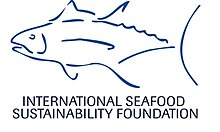
A tuna is a saltwater fish that belongs to the tribe Thunnini, a subgrouping of the Scombridae (mackerel) family. The Thunnini comprise 15 species across five genera, the sizes of which vary greatly, ranging from the bullet tuna up to the Atlantic bluefin tuna, which averages 2 m (6.6 ft) and is believed to live up to 50 years.
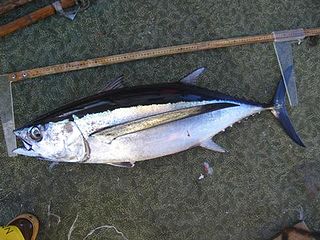
The albacore, known also as the longfin tuna, is a species of tuna of the order Scombriformes. It is found in temperate and tropical waters across the globe in the epipelagic and mesopelagic zones. There are six distinct stocks known globally in the Atlantic, Pacific, and Indian oceans, as well as the Mediterranean Sea. The albacore has an elongate, fusiform body with a conical snout, large eyes, and remarkably long pectoral fins. Its body is a deep blue dorsally and shades of silvery white ventrally. Individuals can reach up to 1.4 m in length.
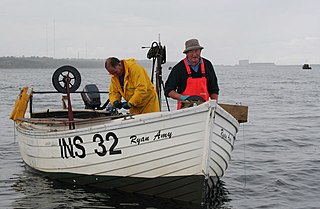
Longline fishing, or longlining, is a commercial fishing angling technique that uses a long main line with baited hooks attached at intervals via short branch lines called snoods or gangions. A snood is attached to the main line using a clip or swivel, with the hook at the other end. Longlines are classified mainly by where they are placed in the water column. This can be at the surface or at the bottom. Lines can also be set by means of an anchor, or left to drift. Hundreds or even thousands of baited hooks can hang from a single line. This can lead to many deaths of different marine species. Longliners – fishing vessels rigged for longlining – commonly target swordfish, tuna, halibut, sablefish and many other species.

The Atlantic bluefin tuna is a species of tuna in the family Scombridae. It is variously known as the northern bluefin tuna, giant bluefin tuna [for individuals exceeding 150 kg (330 lb)], and formerly as the tunny.

The yellowfin tuna is a species of tuna found in pelagic waters of tropical and subtropical oceans worldwide.

The National Marine Fisheries Service (NMFS), informally known as NOAA Fisheries, is a United States federal agency within the U.S. Department of Commerce's National Oceanic and Atmospheric Administration (NOAA) that is responsible for the stewardship of U.S. national marine resources. It conserves and manages fisheries to promote sustainability and prevent lost economic potential associated with overfishing, declining species, and degraded habitats.
The International Commission for the Conservation of Atlantic Tunas (ICCAT) is a tuna regional fishery management organisation, responsible for the management and conservation of tuna and tuna-like species in the Atlantic Ocean and adjacent seas. The organization was established in 1966, at a conference in Rio de Janeiro, Brazil, and operates in English, French and Spanish. The organisation has been strongly criticised by scientists for its repeated failure to conserve the sustainability of the tuna fishery by consistently supporting over-fishing – an internal review branded ICCAT's policies on the eastern Atlantic bluefin tuna fishery a "travesty of fisheries management", and an "international disgrace". Conservationists often refer to ICCAT as "The International Conspiracy to Catch All Tuna".
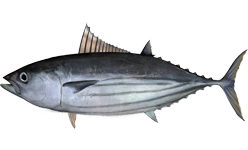
The skipjack tuna is a medium-sized perciform fish in the tuna family, Scombridae, and is the only member of the genus Katsuwonus. It is otherwise known as the balaya, bakulan/kayu, tongkol/aya, aku (Hawaii), cakalang (Indonesia), katsuo, arctic bonito, mushmouth, oceanic bonito, striped tuna or victor fish. It grows up to 1 m (3 ft) in length. It is a cosmopolitan pelagic fish found in tropical and warm-temperate waters. It is a very important species for fisheries.

A fish aggregatingdevice (FAD) is a man-made object used to attract ocean-going pelagic fish such as marlin, tuna and mahi-mahi. They usually consist of buoys or floats tethered to the ocean floor with concrete blocks. FADs attract fish for numerous reasons that vary by species.

The bigeye tuna is a species of true tuna of the genus Thunnus, belonging to the wider mackerel family Scombridae. In Hawaiian, it is one of two species known as ʻahi, the other being the yellowfin tuna. Bigeye tuna are found in the open waters of all tropical and temperate oceans, but not in the Mediterranean Sea.
A regional fishery body (RFB) is a type of international organization that is dedicated to the sustainability of fishery resources in a particular region, or of highly migratory species, whose such capacity has been recognized by the UN Food and Agriculture Organization. An RFB is classified as one of the following two types:
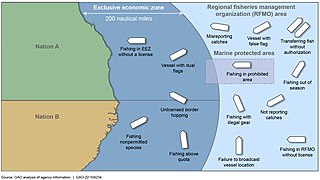
Illegal, unreported and unregulated fishing (IUU) is an issue around the world. Fishing industry observers believe IUU occurs in most fisheries, and accounts for up to 30% of total catches in some important fisheries.
Dolphin-safe labels are used to denote compliance with laws or policies designed to minimize dolphin fatalities during fishing for tuna destined for canning.

The Western and Central Pacific Fisheries Commission (WCPFC) is both a general and a tuna regional fisheries management organisation established to conserve and manage tuna and other highly migratory fish stocks across the western and central areas of the Pacific Ocean. Its full name is Commission for the Conservation and Management of Highly Migratory Fish Stocks in the Western and Central Pacific Ocean. It commenced operations in late 2005, and its secretariat is based in Pohnpei, in the northern Pacific state of the Federated States of Micronesia.
The Nauru Agreement Concerning Cooperation in the Management of Fisheries of Common Interest, or The Nauru Agreement is an Oceania subregional agreement between the Federated States of Micronesia, Kiribati, the Marshall Islands, Nauru, Palau, Papua New Guinea, Solomon Islands and Tuvalu. The eight signatories collectively control 25–30% of the world's tuna supply and approximately 60% of the western and central Pacific tuna supply.

Feng Sushi is a UK-based restaurant chain known for advocating sustainable fish farming. The company was founded in 1999 by chef Silla Bjerrum and chef Jeremy Rose, with restaurant entrepreneur Luke Johnson the majority owner since 2010.
High seas fisheries management refers to the governance and regulation of fishing activities in areas beyond national jurisdiction, often referred to as the 'high seas'. The 1982 United Nations Convention on the Law of the Sea (UNCLOS) and the 1995 United Nations Fish Stock Agreement (UNFSA) provide the international legal framework for the regulation of fishing activities in areas beyond national jurisdiction. The United Nations Fish Stock Agreement delegates responsibility for conservation and management of fish stocks to regional fisheries management organizations (RFMOs) each governing a geographical area of the high seas.

Of the twelve species of billfish, there are six species of Billfish in the Indian Ocean.

US FWS Hugh M. Smith was an American fisheries science research vessel in commission from 1949 to 1959 in the fleet of the United States Department of the Interior's Fish and Wildlife Service. She was among the first U.S. fisheries science vessels to explore the central Pacific Ocean in search of commercially valuable populations of fish.

US FWS Charles H. Gilbert was an American fisheries science research vessel in commission from 1952 to 1970 in the fleet of the United States Department of the Interior's Fish and Wildlife Service and from 1970 to 1973 in the fleet of the National Oceanic Atmospheric Administration as NOAAS Charles H. Gilbert. She was among the first U.S. fisheries science vessels to explore the central Pacific Ocean in search of commercially valuable populations of fish.
